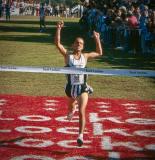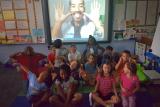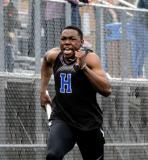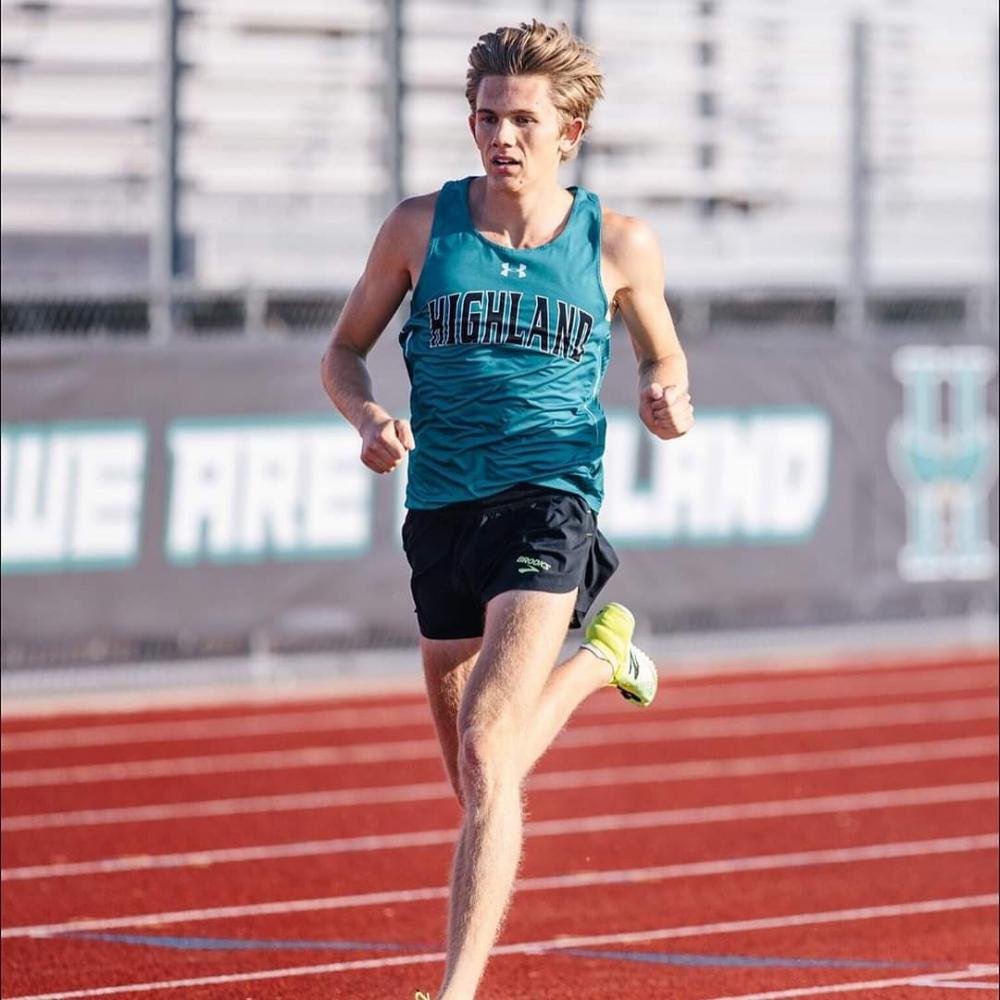Folders |
SOLO SZN: Leo Daschbach And The Effort To Reclaim The 2020 SeasonPublished by
SOLO SZN Arizona star Leo Daschbach carves a path through the quarantine
- Coach Dave “Monty” Montgomery, Highland H.S. ________________ A DyeStat Story By Dave Devine
April 11 - 4:03.7 This isn’t how it was supposed to go. Not with Leo Daschbach, in the spring of his senior year at Highland High (Gilbert, Ariz.), training alone. Not with the defending Arizona Division 1 state champion in the 800, 1,600 and 3,200 meters, slipping onto abandoned high school tracks to urge his body through solo morning workouts before the sun has even topped the bleachers. Securing pacers for glorified time trials. Lining up friends to act as timers and videographers. Firing off text messages to a coach he never sees. Daschbach, even two months ago, couldn’t have imagined his spring unfolding like this. And what about the coach receiving those texts — longtime Highland mentor. Dave “Monty” Montgomery — this isn’t what he imagined, either. How could it be? After nearly 50 years in the sport, more than two decades at this Arizona high school, he had to have seen almost everything that coaching could throw his way, right? Promising senior seasons cut short by injury. Single-digit defeats and missed opportunities. Races and meets cancelled by suddenly violent weather. Athletes leveled by tragedy and loss and bitter disappointment. Coach long enough, and you move through all those things. But a global pandemic that upends a school year? An entire season shuttered, with everyone healthy and ready to roll? There’s no coaching manual for that. Nothing to suggest a plan of action for when the calendar is abruptly erased. When your championship-caliber team is dispersed and drifting. When you experience an almost breathtaking evaporation of possibility and potential. What prepares you for that? What do you do when a kid you’ve helped develop from a raw-but-talented soccer player into the best distance runner you’ve ever coached, sends a text message suggesting you show up at a local track on a Saturday morning to watch him chase a sub-four-minute mile, but — and here’s the kicker — you should probably sit on the backstretch and keep a low profile? If you’re Dave Montgomery, navigating this strangest of track seasons, you wander into the vacant backstretch bleachers, marvel at the emptiness of it all, and watch your runner race the clock. How could you miss it? “We didn’t,” Montgomery says. “My wife and I came in with black hoodies and sunglasses, it was hilarious. I didn’t coach him, we were just up there yelling at him.” What they saw, on an otherwise unoccupied track, was Daschbach shadowing 2019 Campo Verde High graduate and current Grand Canyon University runner Rylan Stubbs through two circuits in 2:01, Stubbs peeling off with 650 meters to go, and Daschbach pressing on alone toward the four-minute barrier. “At that point,” Montgomery says, “Leo was kind of on his own.” Rallying over the final 200 meters, Daschbach tore across the line in a hand-timed 4:03.7, a mark that would have supplanted his own state mile record of 4:03.98 from the Brooks PR Meet last June — if it counted as an official mark. It won’t, of course, which is the maddening thing about these solo attempts, not just for Daschbach, but for prep athletes all around the country seeking to carve a path forward in a canceled season. What to do with all-timer marks in “virtual meets?” Where to place them in an eventual accounting of this truncated season? Watching from the far stands, though, his protégé hunched over from the effort, Montgomery saw something more important than the numbers. More pressing than the finicky discussion about where those numbers will reside in the historical record. He saw a kid who remains hungry. “Leo just has that grit,” Montgomery says. “He can push himself to a place that a lot of people can’t. It’s hard to explain, because you can’t teach it — he’s just got that killer instinct.” Sign up for the NSAF x AthleticNET Virtual Nationals at virtualnationals.com
Hunger Arcadia was the original plan. Focus on the two-mile, get as fit as possible, and take a swing at the big boys in California. “The main reason I wanted to do that,” Daschbach says, “was because that’s where Nico Young, Cole Sprout, Matt (Strangio) — all the best kids across the nation — were going to be running the two-mile. So, the goal was really to go out there and try to win that.” He admits the 3,200 is not his favorite event -- “I enjoy the mile and the 800 so much more,” he says — but the big April invitational would be a chance to race guys he’d matched stride-for-stride during the cross country season before a leg injury sidelined him after his victorious Arizona state meet. Daschbach’s confidence wasn’t misplaced. Back in September, he’d stunned Sprout at the Nike Desert Twilight Festival with the second-fastest 5k in prep cross country history. Two weeks later, he’d chased Young to the line — and beaten Strangio — at the Clovis Invite. Even though he watched from home in December while those three and others battled at Nike Cross Nationals, Daschbach had every reason to believe he’d be squarely in the mix for an epic 3,200-meter showdown at Arcadia. “I knew he’d be hungry when we started in the spring,” Montgomery says. “And he was.” A February trip to the University of Washington (his future collegiate home after signing with the Huskies in the fall) yielded a 4:05.96 indoor mile, only confirming Daschbach’s rebounding fitness. INTERVIEW When he opened his outdoor campaign with a 1:52.38 over 800 meters in the first week of March, trailed closely by senior teammates Ernest Green (1:54.06) and Sam Green (1:54.77), words like “quarantine” and “social distancing” were still distant whispers in Arizona. The spring gleamed with promise. “That wasn’t even a fantastic race for us,” Daschbach recalls. “We had really big aspirations — me and the Greens — for the 800.” The entire Highland team was primed for a big season. State runners-up on the both the boys’ and girls’ sides in 2019, the Hawks were positioned to take a shot at a team double in 2020. “We were loaded,” Montgomery says. “Both teams.” Two months later, the coach now maintains contact with that loaded team via a group text. He’s encouraging the kids to continue training four or five days a week, keep it fun, try to hang on to some fitness. Keenly aware that COVID-19 has dealt far worse blows than his team’s dashed state title dreams. “There’s a lot more adversity out there than this,” he says, “but I just tell the kids to stay positive, work on getting better in your mindset, send them things to read…that’s what I’ve got everyone doing.” Everyone, that is, except Daschbach. As soon as it became clear the meet calendar was vanishing, the senior star texted his coach to say he didn’t feel done. Wasn’t ready to go quietly into a long summer build-up to college. “He just said, ‘I want to keep trying to test myself.’” The plan had always been to pivot to the mile after Arcadia, so coach and runner simply accelerated that transition. “We just moved it up on the list,” Daschbach says, “decided we’d dedicate this whole quarantine season to the sub-4.” One of the most difficult aspects of that pursuit has been the isolation, the knowledge that he’s out there alone when he could be training with talented teammates who would push him every day in practice. “I definitely miss the boys,” he says. “Those guys are your best friends. You run with them every day, you do your long runs, you talk and goof off…it’s just—” He pauses, searching for words to capture the enormity of a loss that might seem small in the face of other coronavirus catastrophes, but is deeply-felt nonetheless. The gap between what he’s doing now — this determined solo pursuit — and the lift and hum you feel surrounded by a pack of teammates in full flight. “It’s just really unfortunate, to have all of that be gone.”
April 25 - 1:49.9 The 800 wasn’t meant to be a showcase. It was just a marker between mile attempts. A hard effort to see how the speed was coming along. Montgomery informed Daschbach he’d be passing on this attempt — skipping the hoodie and the backstretch bleachers this time around. Experience had told the coach that when high schoolers attempt a solo 800, it usually doesn’t go as planned. It’s too difficult to pace correctly. He figured his charge might go anywhere from 1:51 (his personal best) to 1:55; either end of the spectrum was a distinct possibility. Daschbach harbored similar doubts. “I didn’t visualize my splits for that at all,” he says. “I had no idea how fast I was going to run.” Just as he had two weeks earlier, Daschbach arrived at the Gilbert High track with a teammate in tow to serve as timer, then prepared to lay down an all-out effort. No pacer this time, just two laps and the watch. The first circuit felt comfortable; Daschbach cruised through 400 meters in 54 seconds. “At that point,” Montgomery says, “he’s thinking it’s going to be a 1:54, 1:55…nothing spectacular,” But as he hammered the backstraight and angled into the final 200, Daschbach began to realize something special was within reach. Bernie Montoya’s all-time Arizona best from 2013 stood at 1:50.19. With teammate Ryan Lundgreen excitedly waving his iPhone timer across a camera pointed at the finish, Daschbach roared across in 1:49.85. Then he fired off another text to his coach. “He texts me that morning,” Montgomery recalls, “and it says, ‘Coach I ran 1:49.8!’ and I’m like, What?” Unlike the 4:03 mile, which was filmed in its entirety, Daschbach didn’t ask anyone to video the 800. There were no pacers, no fans. No officials or competitors or coaches. Just Daschbach’s parents and a buddy standing trackside with a phone. “He ran 1:49 by himself,” Montgomery says, “and he didn’t have anyone out there but his parents and a friend. It’s just mind-boggling.” After the 4:03 mile, Daschbach had confided to Montgomery that he didn’t feel like he was “there” quite yet. The training was still coming together. A few pieces were missing. “Then he ran the 800,” Montgomery says, “and he told me, ‘Coach, it’s there. I’m ready to break four.”
Heat Arizona, already reliably hot in the spring, saw record temperatures in at the beginning of May. In the Phoenix metro area, where Gilbert sits, thermometers climbed past 100 degrees much earlier than usual. On several days, the mercury topped 105. For Daschbach, that’s meant mornings or evenings are the only workout options. “I’m doing mornings,” he says. “As it’s getting hotter, I’m just going earlier and earlier. It sucks, because I can’t run after, like 7 o’clock. By then, it’s already 80 degrees.” It’s an unavoidable challenge, but Montgomery has long preached weather inconvenience as a competitive advantage. “I tell the kids, ‘I lived in Michigan, and I trained in the winters,’” he says. “And here we have the heat and it toughens you. Getting up early toughens you. The kids know that whatever gets thrown at them, they can handle it.” While Daschbach appreciates the acquired toughness, he acknowledges it would all be easier if he had some people to train with. And that hasn’t been the case for some time. “Since the quarantine started, I’ve pretty much had to do every workout by myself.” Asked for a tell-tale workout or killer session that might have projected the fast times he’s dropping this spring, Daschbach initially draws a blank. “They all just kind of blur together,” he laughs. “And they’re all really hard— which honestly, feels like it’s been the theme of these past two months.” Pressed for details, he mentions a set of 10 400-meter repeats from earlier in the season. “It was like 60’s for the first five, and then 59’s for the last five. Hard, but it was really good.” His coach, not surprisingly, immediately conjures the workout he feels hinted at Daschbach’s spring potential. It began, Montgomery says, with a couple of 800’s: “He ran those in like, 2:13 and then 2:08 or 2:07…short rest…and then he did six 400’s and he just kept cutting them down. The last one was 55 seconds. With a minute rest. I’m like — Holy smokes.” If the workout results have been eye-opening for Montgomery, equally impressive has been the maturity he’s seen in Daschbach as the high schooler manages every aspect of his “virtual races.” “He’s done it all,” Montgomery says. “Honestly,” Daschbach says, “I feel a little more confident when I have some control over it. It is nice to be able to pick the time and place when I want to run.” He notes, with a laugh, that he no longer worries about missing the clerk’s call to report to the line. “I can just be like, ‘I’m ready. Start me.’” The most difficult aspect has been securing reliable pacers. Stubbs, who shepherded him through the first two-and-a-half laps of that 4:03 mile, is focused on base mileage for the collegiate cross country season. “I feel bad asking him to do workouts,” Daschbach says, “just so he can take me through in 1:59 — I feel bad about that. So, I really don’t know where to get pacers.” The Greens, with those 1:54 800’s in early March, have plans to depart on a mission in the fall; they’ve backed off high-level training. And in the end, Daschbach says, it also comes down to personal accountability. If a sub-4 attempt should unravel, he’d prefer the responsibility rest squarely on him. “I don’t want to have someone pace me, and they do a bad job, and then they feel like it’s their fault that I didn’t break four. I’d rather me be bad at pacing me, and then, if it falls apart, it’s my fault.”
May 9 - 4:07 It looked like this would be the day. It felt, to everyone, like fitness and confidence and opportunity had lined up for Daschbach to take a legitimate shot at the four-minute barrier. Unlike the previous April time trials, this one would be held on his home track at Highland High. Montgomery wouldn’t be observing from an isolated vantage across the track; he’d obtained special permission from the superintendent to be present for the run and assist with the logistics. “I told my athletic director, ‘Look, this kid is going to break four,’” Montgomery says, “’and if he does do it, I want him to do it on our track. I don’t want him hopping a fence somewhere and doing it on his own.’ So, they gave me clearance to be there.” A 7 a.m. start time was arranged. An official timing clock was procured from a timing company. A small, socially-distanced group gathered to cheer on the attempt. A drone was planned to film the action from above. All the pieces were there. Except there was no pacer. Daschbach would be gunning it alone for four laps. And by the time he stepped to the line, the unseasonable warmth meant temperatures on the track had already topped 80 degrees. He ran 4:07. “It just wasn’t good,” Daschbach says. “Not every trial is going to be a record, so I’m not too bummed.” But he was disappointed, no way around it. Adding sting to that disappointment was the fact that another high schooler — senior Ryan Schoppe of La Porte, Texas – time-trialed a 4:00.81 the same morning. Video evidence hit the Internet shortly after Schoppe crossed the line. “I saw that,” Daschbach says. “It was incredible.” But he knows that he can’t allow performances happening elsewhere to detract from his own preparation. “I ran 4:07,” he says, “and I just wasn’t happy with that at all. And then Ryan Schoppe runs 4-flat, and if I get all one-uppy and look at that — at the 7 seconds between us — it could kind of crush me. Especially when you’re not racing people head-on, you’re just dropping time trials.” Which brings up the one strength Daschbach hasn’t been able to draw upon this solo season: he’s a dogged competitor in head-to-head situations. “He loves to compete,” Montgomery says. “He doesn’t really care about records, he’s just really into competition.”
History It might be his only shot this spring. The one chance for Daschbach to lace up his spikes with a field talented enough to actually get him there. On pace with a lap to go. Fresh and full of run. He’d be helping to get them there, too, which is the point. A conspiracy of speed. On Saturday, May 23, at an undisclosed track in Sacramento, Calif., at an unnamed time (to deter on-lookers), Daschbach and a small group of fellow milers intend to hook up for a serious attempt at an historic mile. “The idea,” Montgomery says, “is to try to get as many guys under four as they can.” The number and names of competitors have shifted several times in recent days, but Daschbach has been on board since he first learned of the attempt. Sprout should be there, hot off an 8:49 time trial at altitude, and so should Utah stars Thomas Boyden (4:05/8:50 at a meet in March) and Easton Allred (4:14 and 9:10 at the same meet). Strangio was originally expected, after a stellar 4:03 time trial earlier in the spring, but there are reports he won’t compete. Like so many things this season, the logistics have been assembled on the fly, the details shifting and subject to change. “It’s still in the works,” Daschbach says, “parts are still getting figured out. But hopefully it happens, and hopefully it’s fast.” He’s aware, as he has been all spring, that regardless of how fast the race goes, or how many guys propel themselves under four minutes, the marks might never end up in official record books or all-time lists. Still, this Saturday represents a chance — maybe the last chance — for some of the best runners in high school history to stamp their names on this season. To say, record books or not, we were here. All the miles mattered. And for Daschbach, at least, the “official” nature of his marks is immaterial. “I don’t care about records all that much,” he says. “I don’t even care about times all that much. If it weren’t for this quarantine, I wouldn’t even be — Look, I’m just running for times because I don’t have anything else to do.” What about his place in the pantheon of prep runners? That, he says, has never been the point. “Honestly, I’m not all that worried about being remembered as a great high school runner. It doesn’t appeal to me. I want to be known as a great runner, period. Long after high school.” He pauses, lets that sink in. “Right now, I just hope people can look at what I’m doing and be inspired — that’s all. That’s the biggest thing.” More news |
















